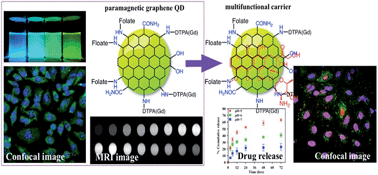Application of paramagnetic graphene quantum dots as a platform for simultaneous dual-modality bioimaging and tumor-targeted drug delivery†
Abstract
Here, we report the development of a multifunctional nanocarrier consisting of paramagnetic graphene quantum dots (GQDs), folate, and doxorubicin (Dox), used as delivery vehicles, a targeting ligand, and a chemotherapeutic drug, respectively. The paramagnetic GQDs, named folate–GdGQDs, were successfully prepared by covalently conjugating diethylenetriaminepentaacetic acid gadolinium and folic acid onto the surface of GQDs. The resultant folate–GdGQDs, which showed a longitudinal relaxivity r1 of 11.49 mM−1 s−1, greatly enhanced the brightness of the T1-weighted magnetic resonance (MR) images, indicating their potential for use as positive contrast agents for MR imaging (MRI). The feasibility of utilizing the folate–GdGQDs with strong luminescence emissions for targeted imaging of HeLa cells was also evaluated. An in vitro cell (HeLa and HepG2 cells) viability assay and in vivo evaluation of toxicity to the embryonic development of zebrafish showed that these folate–GdGQDs exhibited negligible cytotoxicity and excellent biocompatibility within the given range of concentrations. More importantly, strong therapeutic activity was achieved by loading Dox onto the surfaces of folate–GdGQDs through π–π stacking and hydrophobic interactions, leading to the formation of folate–GdGQD/Dox multifunctional nanocarriers. Approximately 80% of the loaded Dox was released from the folate–GdGQD/Dox nanocarriers under mild acidic conditions (pH 5.0), whereas only 20% of Dox was released at pH 7.0 after 48 h. Furthermore, these multifunctional nanocarriers could efficiently induce an inhibitory effect on HeLa cells, as confirmed by an in vitro cytotoxicity assay. The combined flow cytometry analysis and confocal laser scanning microscopic observation showed that these nanocarriers were efficiently taken up by the cancer cells overexpressing folate receptors. Taken together, these results suggested that the multifunctional nanocarriers could be used as promising targeted drug delivery vehicles for the diagnosis and image-guided chemotherapy of various cancers.

- This article is part of the themed collections: JMC B Top Picks web collection: Seeing the unseen: Advances in bioimaging and biosensors and JMC B Top Picks collection: Recent advances in drug delivery

 Please wait while we load your content...
Please wait while we load your content...